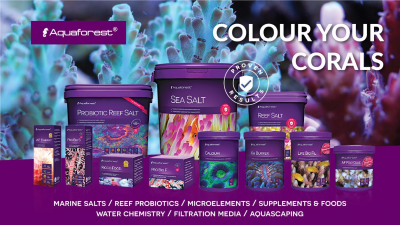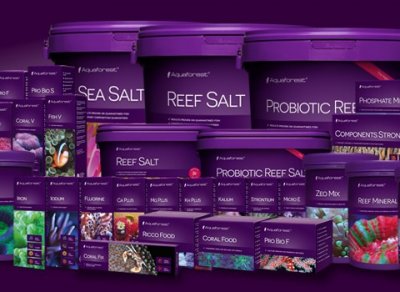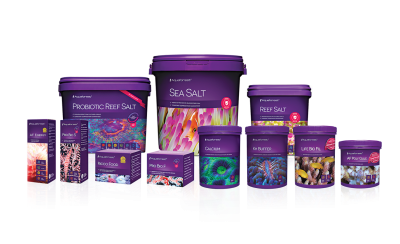All images of coral colonies and zeolite are public domain images sourced from iStock. AquaForest product images provided by AquaForest.
Around reef2reef anyone can catch a glimpse of discussion about AquaForest products. With the ongoing thread that displays gorgeous reef tanks implementing AquaForest’s products, it’s sure to catch at least a few reef keeper’s attention. There is a segment of the reef keeping population sure to take notice of AquaForest, and that’s those of us who use zeolite or zeovit. I have no way of knowing what percentage of reef aquarists implement a zeolite reactor. Zeolite use isn’t as simple as carbon or GFO use and is a more 360-degree reef keeping methodology, based on the attributes of zeolite, a naturally occurring (and industrially produced) mineral. Zeolite is used in everything from cat litter to detergent and is known for an uncanny ability to absorb nutrients, discoloration and odors. In reef aquarium filtration, it’s zeolites micro-porous nature that makes it valuable. These micro-pores within each individual zeolite stone make it an ideal home for anaerobic bacteria, which thrive in low oxygen environments and remove phosphate and nitrate. A property cycled and maintained zeolite reactor can strip nutrients from water while zeolites’ other attributes can enhance the effect of various additives.
Zeolite users (myself among them) feel like the mineral gives us a greater level of control over our tank’s inhabitants. Nutrients that provide undesirable results (such as coral bleaching and discoloration) are removed and additives can be used to tweak everything from growth up to coloration. Do you want frags to grow into colonies quicker, tweak your zeolite based additives to achieve faster growth. Satisfied with the current size of your colonies, but not their color, tweak your zeolite additives for enhanced reds or greens.
However, zeolite isn’t for every reef keeper and it comes with some inherent risks. Cycled too quickly, a zeolite reactor can deplete nutrients from a reef tank so swiftly that corals suffer from rapid tissue narcosis. Without appropriate media changes and daily shaking, zeolite becomes clogged by bio-slime and debris rendering it essentially useless. Media shaking can seem like a tedious task and to make matters worse, it clouds aquarium water for up to several hours. The trade-off is that the mulm (bacterial slime) serves as a great food for corals. Various zeolite reactors offer automated shaking, sporting built-in motors that rotate the reactor and can be programmed via an aquarium controller.
Up until now:
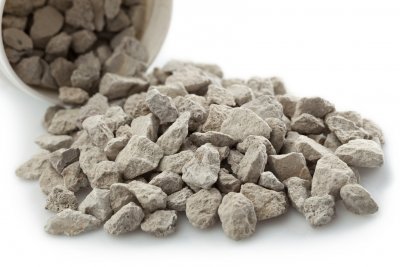
Zeolite stones are both naturally occurring and industrially produced. They have a wide array of uses, however their micro-porous nature makes them very effective at harboring anaerobic bacteria.
While several aquarium filtration manufacturers offer their own line of zeolite, it’s without a doubt that the most entrenched zeolite community has been built around Korallin-Zucht’s zeovit line of products. Zeovit is a common moniker in aquarium filtration and is used to describe Korallin’s specific zeolite media along with the additives, reactors and methodology that works with it. There are a host of products that bare the zeovit badge; bacterial additives, soluble carbon, amino acids, vital trace elements, activated carbon and more. Everything is enhanced by filtration with zeovit material and most amplify the ability for zeovit to remove nutrients and buffer trace elements. For most zeolite users, Korallin’s products are high performers and if an aquarist properly maintains a zeovit based system, they are often rewarded with tremendous results. Many of us have seen photos of zeolite based systems with almost outrageous coloration and accelerated coral growth. In many ways, the use of zeolite has allowed aquarists to push the envelope of water chemistry and thus achieve incredible reef systems.
Zeolite use for me was a turning point in my reef career. A while back, I felt like I had hit a brick wall in reef keeping. I was successful in that I could maintain a vibrant mixed reef and even propagate various corals for trade with fellow aquarists. Yet, like many aquarists, I wanted more and sought a way to push the envelope of closed system filtration and accomplish faster growth, richer colors and take control over what took place within my tank. Back then, the use of zeolite in reef aquariums was rather new, having recently been brought to the U.S. from Norway, Denmark and Germany. There was a lot of confusion among zeolite users as to what system worked best, or how to mitigate risks and maximize results. With a lot of time and personal research, I began to understand how the system performed and was able to achieve my goals of maximizing coral health. Since then, Korallin Zucht’s zeovit system has remained the premiere way to implement zeolite on a reef tank. A large forum of zeovit users has arisen online and specific methodologies can be found, detailing to the millimeter how to get results from zeovit.
AquaForest:
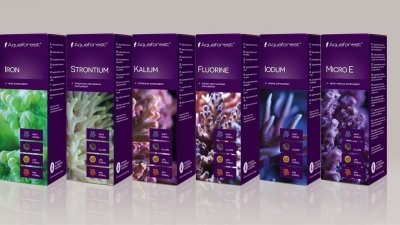
Trace element dosing is an important part of zeolite use, giving the aquarist a high degree of control over specific coral traits.
When I first read about AquaForest I was certainly intrigued. Like zeovit, it was a methodology and product of European descent, originating in Poland. In recent years, various nations such as Poland, Austria, Denmark, Sweden and others have been praised for their unique innovations. In 1995 AquaForest began creating substrates and filtration media for zoos, aquariums and commercial farms. Within time, AquaForest established its own aquatic plant and coral farms and began producing products for use in house. Their research and development led them to create products which appeared to out produce the competition and in 2011 they decided their various discoveries deserved be shared with the international reef keeping community. However, it would be another four years until American reef keepers would hear about AquaForest, when in 2015 Deepwater Aquatics began distributing their products.
For any zeovit user looking into AquaForest, I can confidently say that AquaForest’s zeolite inclusive methodology is not zeovit. I don’t mean that in a negative way, but simply to point out that other than relying on a similar mineral and bacteria, the two are very different. Zeovit is a very hands-on approach to reef keeping that requires daily maintenance of the filtration media and consistent dosing. AquaForest’s method also requires dosing and maintenance, but has been simplified to make the whole process more inviting and less risky. An aquarist could say that AquaForest is Apple Computer and zeovit is Microsoft.
AquaForest’s methodology and product, like zeovit, revolves around microbes and their role in biological filtration. It’s hard to pinpoint the centerpiece of the system. With zeovit it’s clearly the zeolite material. With AquaForest it’s a toss-up between the zeolite media and the probiotic reef salt. The probiotic reef salt doesn’t seem like a breakthrough at first glance. I’ve noticed some concerns here on reef2reef about the salt and whether or not the bacteria would become problematic, if left for long periods of time without use. The jury is still out on this debate; however, I recommend making only the amount of saltwater you need at any given time and using it all within a day. Some aquarists like to have a high volume of marine water on hand in the case of emergency and it may be best to use a mix that isn’t seeded with bacteria.
If your denitrification method revolves around microbes (as mine does, and always has) probiotic reef salt certainly is a unique innovation. The probiotic salt enhances traditional reef salt mix with the same types of microbes a zeovit user would be dosing on a regular basis, which then colonize zeolite material and begin the process of denitrification. Using them in the salt is an interesting strategy, as most of us still perform weekly water changes. Instead of spreading-out micro-doses of bacteria, one moderate water change provides a robust replenishing of micro-organisms to keep the zeolite seeded. I was wary of the process, but found that the AquaForest system remained functional using the probiotic reef salt. The probiotic salt may provide other benefits, but as of yet I can’t verify that. I can verify that using AquaForest’s zeolite product and probiotic salt, along with weekly 20% water changes, I am able to achieve the same results I did with zeovit and daily dosing of soluble carbon and bacterial boosters.
Yet not everyone does weekly water changes and some reef keepers are pioneering methodologies that call for little, if any water changes. Is the AquaForest methodology possible if water changes aren’t present to maintain the microbe population? AquaForest has released several bacterial additives and carbon solutions to boost microbe population and maintain zeolites’ functionality in the absence of probiotic water changes. ProBio S is a blend specifically aimed at maintaining microbes that assimilate nitrate and phosphate, while Bio S is aimed at replenishing and maintaining aerobic bacteria which assimilates ammonia and nitrite. NP Pro is advertised as a culture media for de-nitrifying bacteria, allowing for rapid growth, but I assume it’s a fancy way of offering soluble carbon. I experimented with both weekly probiotic water changes and four week intervals of using only the additives and found the system performed the same under both circumstances.
Oddly enough, AquaForest also offers a GFO phosphate removal media. It seems counter-productive, as one of zeolites purposes is to remove phosphate. Korallin specifically recommends removing GFO media from any zeovit based system, so it’s possible that AquaForest’s GFO is intended solely for systems that aren’t using zeolite. However, it’s not terribly uncommon to find tanks employing both zeolite and GFO for phosphate removal. Phosphate is a blanket term that describes a host of compounds within water, some of which are very harmful, others degrade coral health and a few do little, if anything at all. Many aquarists have found that having multiple phosphate reduction methods on a tank doesn’t seem to cause any harm, but just may remove multiple types of problematic phosphates. Again, this is simply anecdotal, but I have personally used multiple phosphate reduction methods without a notable problem. The primary issue with running GFO is depletion of iron, which can easily be accounted for with an iron additive and if you’re not using macro-algae as a filtration method, it may not cause any issues whatsoever. If zeolite is being used in aquaria to accomplish de-nitrification, it’s unlikely that macro-algae is as well. That said, anyone new to us
ing zeolite should try to achieve adequate nitrate and phosphate removal with zeolite alone, simply because over-filtration is a hassle if it isn’t accomplishing a particularly needed goal.
Aesthetics, pricing and packaging:
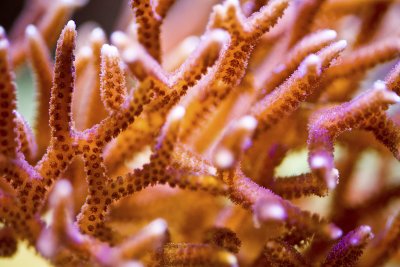
Zeolite is typically used to heighten polyp extension and maintain vivid color, even in delicate SPS coral species.
One thing that always bothered me about Korallin’s zeovit based products was the packaging itself. Everything is arranged in very bland blue bottles, with trademark white lids. I’ve had Zeobak and Sponge Power dropper lids fail, within a few days of opening a new bottle. For premium priced marine aquarium products, they look bland and uninteresting. AquaForest on the other hand has some of aquatics most beautiful and well packaged products. Each additive and product comes in a purple colored container, fitted with a startling image of thriving reef life. Even better, the bottles and droppers, along with the salt container are all top notch, easy to use and very durable. It may seem like a minor concern, but many of us showcase our dosing products along with our tanks, so having something aesthetically pleasing beats the alternative.
The best I’ve saved for last; AquaForest’s products are packaged better than Korallin’s zeovit line, but are actually a bit cheaper. Since there are quite a few less dosing requirements to complete AquaForest’s methodology the savings is considerable.
Overall:
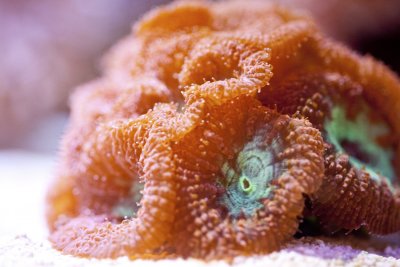
LPS corals too can benefit from a proper zeolite routine, but the aquarist must feed the coral and dose the proper nutrients, or it's likely the colony will wither quickly or over time.
Based on my own personal testing over the past few months, my aquarium’s water chemistry is nearly indistinguishable using AquaForest’s products, from when I was using zeovits, even the AquaForest method is simpler and more cost effective. Now a few months is far from a conclusive study in the reef aquarium world, but it certainly is promising given how much easier the AquaForest method of zeolite use is when compared to others. I am certainly not suggesting that aquarists pleased with zeovit abandon it for AquaForest. I am suggesting that if aquarists feel burdened by their zeovit routine that AquaForest may offer a plausible, simpler solution – at a better price. AquaForest’s promise is a healthy, stable and thriving reef tank and based on what I’ve seen so far, they may be on to something.
Around reef2reef anyone can catch a glimpse of discussion about AquaForest products. With the ongoing thread that displays gorgeous reef tanks implementing AquaForest’s products, it’s sure to catch at least a few reef keeper’s attention. There is a segment of the reef keeping population sure to take notice of AquaForest, and that’s those of us who use zeolite or zeovit. I have no way of knowing what percentage of reef aquarists implement a zeolite reactor. Zeolite use isn’t as simple as carbon or GFO use and is a more 360-degree reef keeping methodology, based on the attributes of zeolite, a naturally occurring (and industrially produced) mineral. Zeolite is used in everything from cat litter to detergent and is known for an uncanny ability to absorb nutrients, discoloration and odors. In reef aquarium filtration, it’s zeolites micro-porous nature that makes it valuable. These micro-pores within each individual zeolite stone make it an ideal home for anaerobic bacteria, which thrive in low oxygen environments and remove phosphate and nitrate. A property cycled and maintained zeolite reactor can strip nutrients from water while zeolites’ other attributes can enhance the effect of various additives.
Zeolite users (myself among them) feel like the mineral gives us a greater level of control over our tank’s inhabitants. Nutrients that provide undesirable results (such as coral bleaching and discoloration) are removed and additives can be used to tweak everything from growth up to coloration. Do you want frags to grow into colonies quicker, tweak your zeolite based additives to achieve faster growth. Satisfied with the current size of your colonies, but not their color, tweak your zeolite additives for enhanced reds or greens.
However, zeolite isn’t for every reef keeper and it comes with some inherent risks. Cycled too quickly, a zeolite reactor can deplete nutrients from a reef tank so swiftly that corals suffer from rapid tissue narcosis. Without appropriate media changes and daily shaking, zeolite becomes clogged by bio-slime and debris rendering it essentially useless. Media shaking can seem like a tedious task and to make matters worse, it clouds aquarium water for up to several hours. The trade-off is that the mulm (bacterial slime) serves as a great food for corals. Various zeolite reactors offer automated shaking, sporting built-in motors that rotate the reactor and can be programmed via an aquarium controller.
Up until now:

Zeolite stones are both naturally occurring and industrially produced. They have a wide array of uses, however their micro-porous nature makes them very effective at harboring anaerobic bacteria.
While several aquarium filtration manufacturers offer their own line of zeolite, it’s without a doubt that the most entrenched zeolite community has been built around Korallin-Zucht’s zeovit line of products. Zeovit is a common moniker in aquarium filtration and is used to describe Korallin’s specific zeolite media along with the additives, reactors and methodology that works with it. There are a host of products that bare the zeovit badge; bacterial additives, soluble carbon, amino acids, vital trace elements, activated carbon and more. Everything is enhanced by filtration with zeovit material and most amplify the ability for zeovit to remove nutrients and buffer trace elements. For most zeolite users, Korallin’s products are high performers and if an aquarist properly maintains a zeovit based system, they are often rewarded with tremendous results. Many of us have seen photos of zeolite based systems with almost outrageous coloration and accelerated coral growth. In many ways, the use of zeolite has allowed aquarists to push the envelope of water chemistry and thus achieve incredible reef systems.
Zeolite use for me was a turning point in my reef career. A while back, I felt like I had hit a brick wall in reef keeping. I was successful in that I could maintain a vibrant mixed reef and even propagate various corals for trade with fellow aquarists. Yet, like many aquarists, I wanted more and sought a way to push the envelope of closed system filtration and accomplish faster growth, richer colors and take control over what took place within my tank. Back then, the use of zeolite in reef aquariums was rather new, having recently been brought to the U.S. from Norway, Denmark and Germany. There was a lot of confusion among zeolite users as to what system worked best, or how to mitigate risks and maximize results. With a lot of time and personal research, I began to understand how the system performed and was able to achieve my goals of maximizing coral health. Since then, Korallin Zucht’s zeovit system has remained the premiere way to implement zeolite on a reef tank. A large forum of zeovit users has arisen online and specific methodologies can be found, detailing to the millimeter how to get results from zeovit.
AquaForest:

Trace element dosing is an important part of zeolite use, giving the aquarist a high degree of control over specific coral traits.
When I first read about AquaForest I was certainly intrigued. Like zeovit, it was a methodology and product of European descent, originating in Poland. In recent years, various nations such as Poland, Austria, Denmark, Sweden and others have been praised for their unique innovations. In 1995 AquaForest began creating substrates and filtration media for zoos, aquariums and commercial farms. Within time, AquaForest established its own aquatic plant and coral farms and began producing products for use in house. Their research and development led them to create products which appeared to out produce the competition and in 2011 they decided their various discoveries deserved be shared with the international reef keeping community. However, it would be another four years until American reef keepers would hear about AquaForest, when in 2015 Deepwater Aquatics began distributing their products.
For any zeovit user looking into AquaForest, I can confidently say that AquaForest’s zeolite inclusive methodology is not zeovit. I don’t mean that in a negative way, but simply to point out that other than relying on a similar mineral and bacteria, the two are very different. Zeovit is a very hands-on approach to reef keeping that requires daily maintenance of the filtration media and consistent dosing. AquaForest’s method also requires dosing and maintenance, but has been simplified to make the whole process more inviting and less risky. An aquarist could say that AquaForest is Apple Computer and zeovit is Microsoft.
AquaForest’s methodology and product, like zeovit, revolves around microbes and their role in biological filtration. It’s hard to pinpoint the centerpiece of the system. With zeovit it’s clearly the zeolite material. With AquaForest it’s a toss-up between the zeolite media and the probiotic reef salt. The probiotic reef salt doesn’t seem like a breakthrough at first glance. I’ve noticed some concerns here on reef2reef about the salt and whether or not the bacteria would become problematic, if left for long periods of time without use. The jury is still out on this debate; however, I recommend making only the amount of saltwater you need at any given time and using it all within a day. Some aquarists like to have a high volume of marine water on hand in the case of emergency and it may be best to use a mix that isn’t seeded with bacteria.
If your denitrification method revolves around microbes (as mine does, and always has) probiotic reef salt certainly is a unique innovation. The probiotic salt enhances traditional reef salt mix with the same types of microbes a zeovit user would be dosing on a regular basis, which then colonize zeolite material and begin the process of denitrification. Using them in the salt is an interesting strategy, as most of us still perform weekly water changes. Instead of spreading-out micro-doses of bacteria, one moderate water change provides a robust replenishing of micro-organisms to keep the zeolite seeded. I was wary of the process, but found that the AquaForest system remained functional using the probiotic reef salt. The probiotic salt may provide other benefits, but as of yet I can’t verify that. I can verify that using AquaForest’s zeolite product and probiotic salt, along with weekly 20% water changes, I am able to achieve the same results I did with zeovit and daily dosing of soluble carbon and bacterial boosters.
Yet not everyone does weekly water changes and some reef keepers are pioneering methodologies that call for little, if any water changes. Is the AquaForest methodology possible if water changes aren’t present to maintain the microbe population? AquaForest has released several bacterial additives and carbon solutions to boost microbe population and maintain zeolites’ functionality in the absence of probiotic water changes. ProBio S is a blend specifically aimed at maintaining microbes that assimilate nitrate and phosphate, while Bio S is aimed at replenishing and maintaining aerobic bacteria which assimilates ammonia and nitrite. NP Pro is advertised as a culture media for de-nitrifying bacteria, allowing for rapid growth, but I assume it’s a fancy way of offering soluble carbon. I experimented with both weekly probiotic water changes and four week intervals of using only the additives and found the system performed the same under both circumstances.
Oddly enough, AquaForest also offers a GFO phosphate removal media. It seems counter-productive, as one of zeolites purposes is to remove phosphate. Korallin specifically recommends removing GFO media from any zeovit based system, so it’s possible that AquaForest’s GFO is intended solely for systems that aren’t using zeolite. However, it’s not terribly uncommon to find tanks employing both zeolite and GFO for phosphate removal. Phosphate is a blanket term that describes a host of compounds within water, some of which are very harmful, others degrade coral health and a few do little, if anything at all. Many aquarists have found that having multiple phosphate reduction methods on a tank doesn’t seem to cause any harm, but just may remove multiple types of problematic phosphates. Again, this is simply anecdotal, but I have personally used multiple phosphate reduction methods without a notable problem. The primary issue with running GFO is depletion of iron, which can easily be accounted for with an iron additive and if you’re not using macro-algae as a filtration method, it may not cause any issues whatsoever. If zeolite is being used in aquaria to accomplish de-nitrification, it’s unlikely that macro-algae is as well. That said, anyone new to us
ing zeolite should try to achieve adequate nitrate and phosphate removal with zeolite alone, simply because over-filtration is a hassle if it isn’t accomplishing a particularly needed goal.
Aesthetics, pricing and packaging:

Zeolite is typically used to heighten polyp extension and maintain vivid color, even in delicate SPS coral species.
One thing that always bothered me about Korallin’s zeovit based products was the packaging itself. Everything is arranged in very bland blue bottles, with trademark white lids. I’ve had Zeobak and Sponge Power dropper lids fail, within a few days of opening a new bottle. For premium priced marine aquarium products, they look bland and uninteresting. AquaForest on the other hand has some of aquatics most beautiful and well packaged products. Each additive and product comes in a purple colored container, fitted with a startling image of thriving reef life. Even better, the bottles and droppers, along with the salt container are all top notch, easy to use and very durable. It may seem like a minor concern, but many of us showcase our dosing products along with our tanks, so having something aesthetically pleasing beats the alternative.
The best I’ve saved for last; AquaForest’s products are packaged better than Korallin’s zeovit line, but are actually a bit cheaper. Since there are quite a few less dosing requirements to complete AquaForest’s methodology the savings is considerable.
Overall:

LPS corals too can benefit from a proper zeolite routine, but the aquarist must feed the coral and dose the proper nutrients, or it's likely the colony will wither quickly or over time.
Based on my own personal testing over the past few months, my aquarium’s water chemistry is nearly indistinguishable using AquaForest’s products, from when I was using zeovits, even the AquaForest method is simpler and more cost effective. Now a few months is far from a conclusive study in the reef aquarium world, but it certainly is promising given how much easier the AquaForest method of zeolite use is when compared to others. I am certainly not suggesting that aquarists pleased with zeovit abandon it for AquaForest. I am suggesting that if aquarists feel burdened by their zeovit routine that AquaForest may offer a plausible, simpler solution – at a better price. AquaForest’s promise is a healthy, stable and thriving reef tank and based on what I’ve seen so far, they may be on to something.



